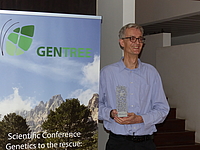Political agreements on climate change and biodiversity might not be enough to protect forests until the next century. The conference wrapping up the four years of GenTree focused on how genetics can rescue forests from the pressures they face, mostly imposed by us, human beings. The conference hashtag — #rescueforests — was chosen to reflect that.
The current trend of carbon emissions puts us on a path to +3°C global temperature increase since the beginning of the Industrial Revolution, far higher than the goals set by the Paris Agreement in 2015.
Efforts at mitigation are currently lagging behind existing moderate targets. This means that forests will have to rely on natural processes to be resilient and adapt to new conditions, processes in which genetic diversity has a significant part to play. Indeed, genetic diversity is the raw material for evolution to act, allowing trees to adapt by natural selection and artificial breeding alike. Evolution offers a nature-based solution for adapting forests and forestry to climate change while preserving biodiversity.

The conference “Genetics to the rescue - Managing forests sustainably in a changing world” thus focused on genetics and forests, and especially on how diversity is structured in space. It also tackled local adaptation, diversity of phenotypes and how phenotypes are determined by underlying gene diversity. Last but not least, the 200 participants, who included representatives from forest management, forest administration and forest policy agencies, talked about how to conserve and use this genetic diversity.
Bruno Fady, a forest geneticist at the French National Institute for Agricultural Research and conference organizer, said, “It was really exciting to organize this conference and I have to thank my colleagues at INRAE forest research in Avignon for that. I was especially proud that the GenTree community responded so positively, providing more than half of the talks and posters presented there. The conference and its companion events — the stakeholder consultation, the genomics training session, the Wikipedia training session and the photo exhibit — generated wide ranging interest. It was all a great success.”

One of the clear messages to emerge from the conference was that forest managers will need to harness genetic differences, both among individual trees and across populations of a species, for sustainable management under uncertain future environmental and socio-economic conditions. This formed the basis of a stakeholder discussion of the conference results, during a consultation to outline future research needs.
Can genetics save and rescue forests? Not without serious efforts to mitigate greenhouse gas emissions. To that end, the conference adopted a carbon price of 40 euros a ton, considerably higher than the average European price of 25 euros a ton, and contributed 2000 euros to a reforestation project in the south of France in order to offset the emissions of conference delegates’ travel.
“If mitigation efforts keep global temperature increase below 2°C,” said Bruno Fady, “forest management, from protected areas to plantation forests, can certainly harness genetic diversity to increase the resilience of forests into the 21st century and beyond.”
Press coverage:
Institut Européen de la Forêt Cultivée 'La génétique à la rescousse'



